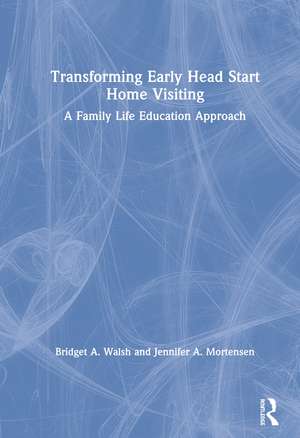Transforming Early Head Start Home Visiting: A Family Life Education Approach
Autor Bridget A. Walsh, Jennifer A. Mortensenen Limba Engleză Hardback – 14 noi 2019
This text is the first to outline linkages between FLE and EHS home visiting. It explores a qualitative study of FLE integrated in a current EHS home-based program and application of FLE methodology to home visiting topics. This approach will influence professional practice and provide a foundation for developing evidence-based home visiting practices. Online content accompanies the text, with videos demonstrating the FLE approach in action and discussion questions to encourage engagement with and understanding of the core material.
Transforming Early Head Start Home Visiting: A Family Life Education Approach is essential reading for upper-level undergraduate and masters students in family studies and early childhood education, as well as practitioners working with children and families.
Preț: 773.51 lei
Preț vechi: 1032.86 lei
-25% Nou
Puncte Express: 1160
Preț estimativ în valută:
148.02€ • 152.93$ • 123.13£
148.02€ • 152.93$ • 123.13£
Carte tipărită la comandă
Livrare economică 19 martie-02 aprilie
Preluare comenzi: 021 569.72.76
Specificații
ISBN-13: 9781138037090
ISBN-10: 1138037095
Pagini: 438
Ilustrații: 7
Dimensiuni: 178 x 254 x 26 mm
Greutate: 0.97 kg
Ediția:1
Editura: Taylor & Francis
Colecția Routledge
Locul publicării:Oxford, United Kingdom
ISBN-10: 1138037095
Pagini: 438
Ilustrații: 7
Dimensiuni: 178 x 254 x 26 mm
Greutate: 0.97 kg
Ediția:1
Editura: Taylor & Francis
Colecția Routledge
Locul publicării:Oxford, United Kingdom
Cuprins
Foreword
Preface
Chapter 1 Introduction to Family Life Education: A Historical Perspective
Chapter 2 The State of Early Head Start Home Visiting
Chapter 3 Family Life Education: A Foundation for Early Head Start Home Visiting
Chapter 4 Family Life Education Approach to Home Visiting: A Qualitative Study
Chapter 5 Reflective Practice
Chapter 6 Building and Supporting Relationships
Chapter 7 Supporting Development and Learning
Chapter 8 Health and Safety
Chapter 9 Observing Behavior, Development, and Environments
Chapter 10 Guidance of Infant/Toddler Behaviors
Chapter 11 Partnering with and Supporting Families
Chapter 12 Diversity and Inclusion with an Emphasis on Supporting Families of Infants/Toddlers with Special Needs
Chapter 13 Professionalism
Chapter 14 Supporting Competencies in Adults
Chapter 15 Promises and Challenges for the Interface of Home Visiting and Family Life Education
Chapter 16 Training to Promote a Family Life Education Approach to Early Head Start Home Visiting
Appendix A Introduction to Early Head Start Home Visiting: One Program’s Description
Appendix B Competencies for Pre-Service Home Visitors Alignment
Appendix C FLE as an Enhancement to Parents as Teachers
Appendix D How to Become a CFLE
Preface
Chapter 1 Introduction to Family Life Education: A Historical Perspective
Chapter 2 The State of Early Head Start Home Visiting
Chapter 3 Family Life Education: A Foundation for Early Head Start Home Visiting
Chapter 4 Family Life Education Approach to Home Visiting: A Qualitative Study
Chapter 5 Reflective Practice
Chapter 6 Building and Supporting Relationships
Chapter 7 Supporting Development and Learning
Chapter 8 Health and Safety
Chapter 9 Observing Behavior, Development, and Environments
Chapter 10 Guidance of Infant/Toddler Behaviors
Chapter 11 Partnering with and Supporting Families
Chapter 12 Diversity and Inclusion with an Emphasis on Supporting Families of Infants/Toddlers with Special Needs
Chapter 13 Professionalism
Chapter 14 Supporting Competencies in Adults
Chapter 15 Promises and Challenges for the Interface of Home Visiting and Family Life Education
Chapter 16 Training to Promote a Family Life Education Approach to Early Head Start Home Visiting
Appendix A Introduction to Early Head Start Home Visiting: One Program’s Description
Appendix B Competencies for Pre-Service Home Visitors Alignment
Appendix C FLE as an Enhancement to Parents as Teachers
Appendix D How to Become a CFLE
Notă biografică
Bridget A. Walsh is an Associate Professor of Human Development and Family Studies at the University of Nevada, Reno. In 2016, NCFR awarded her with the honor of CFLE of the year. She is co-chair of the NCFR home visiting focus group. She is chair of the Coaching Workgroup of the Ounce of Prevention’s Community of Practice, Professional Development for home visitors.
Jennifer A. Mortensen is an Assistant Professor of Human Development and Family Studies at the University of Nevada, Reno. She is a fellow with the Doris Duke Fellowship for the Promotion of Child Well-Being. She is also a CFLE and co-chair of the NCFR home visiting focus group. Her research focuses on parenting and childcare for families with infants and toddlers. She draws inspiration for this work from her time as a teacher at Early Head Start.
Jennifer A. Mortensen is an Assistant Professor of Human Development and Family Studies at the University of Nevada, Reno. She is a fellow with the Doris Duke Fellowship for the Promotion of Child Well-Being. She is also a CFLE and co-chair of the NCFR home visiting focus group. Her research focuses on parenting and childcare for families with infants and toddlers. She draws inspiration for this work from her time as a teacher at Early Head Start.
Descriere
In this essential guide, Walsh and Mortensen propose that alignment with Family Life Education’s (FLE) strengths-based methodology results in greater consistency through a model of prevention, education, and collaboration with families.
